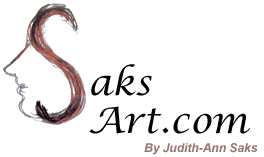Over the Horizon
Over the Horizon blends the present with the out look for the future. The basis for this painting was the architectural plans for Barbours Cut Terminal, the construction of which had recently begun as the painting was started; knowledge, either previously known or researched; and advice from many persons. Barbours Cut Terminal is designed to handle large ships - too large to easily navigate the Ship Channel, which seemed relatively more narrow as the ships became larger, or which required a depth too great to pass over the Baytown or Washburn tunnels. These tunnels allow automobile and truck traffic to cross beneath the Ship Channel.
When this scene was painted, the facilities in existence consisted of the radar tower, which for years monitored, by closed circuit television, the traffic in the Ship Channel; the U-shaped concrete dock shown in this painting running out to the LASH ship with the large yellow crane; and the container yard under construction next to the position where the container ship HOUSTON was placed. The two huge Paceco cranes were being assembled.
At the time of this painting, the HOUSTON, a Sea-Land container ship in service, was docking in the vicinity of the turning basin. It is hoped that affection for its name will cause its maintenance to be such that it will remain in service. Above it, a huge container ship typical of the year 2001, is moving in the Ship Channel toward the radar tower.
The ship to the left of the HOUSTON with a large yellow crane is a lash ship meaning "lighter aboard ship", a lighter being a small barge used for transferring cargo. The crane moves the length of the ship loaded with containers or other cargo. The crane loads and arranges the barges on the ship at their port of origin. At the port of destination, either docked or off shore, it unloads the barges into the water where a tug will take over and move the barge to its destination. This procedure had been used for some time in Europe on the Rhine and other rivers, but was just taking hold in the United States when the painting began. In the painting, a tug is waiting for a barge near the rear of the LASH ship (one the artist inspected was the lenghth of three football fields, placed end to end). In the lower left corner is a tug pushing a barge to an area where the barges were stored, waiting to be taken to their final destination.
The red ship between the HOUSTON and the metal warehouse is a Ro-Ro (roll on, roll off) ship. The back of the ship is a rectangular flat surface which is lowered on a hinge at the bottom making a "gang plank" to the dock. The vessel is loaded and unloaded by driving vehicles or pushing or pulling wheeled trailers on and off the ship. This, too, was a new method for shipping cargo. The contract for building this dock for Ro-Ro ships was awarded the day the paintings were presented to the Port Commissioners.
To the left, at the rear of the huge container ship, is a tower with a flattened sphere. Many people suggested that Barbours Cut Terminal needed a restaurant. This is one with a revolving dining room from which the activities of the Port may be viewed. It is hoped that in the future, this or something like it, may be constructed.
To the left of the radar is a boat with foam churning on it. This is the artist version of a new SAM HOUSTON. At the time this picture was painted, the SAM HOUSTON, then commanded by Captain O. Shepherd, was the only port inspection boat in the world which took sight-seers free for a tour of the port. The artist envisioned a hydroplane of the future carrying many more passengers.
The area to the right is the storage yards for the containers. Each of the two container wharves has thirty-six acres of graded land and seven acres of paved marshalling area. There is space for twenty-seven hundred containers and fifty electrical outlets for refrigerated containers. A new computer system regulates the movement of the containers with quick access to any information about location, contents or conditions of all containers in the yard. In addition to loading and unloading, there are three Le Tourneau yard cranes to stock containers. Some observers mentioned that they could pick out in the paintings which company owned the various containers from their color and appearance.
Much help and advice regarding the Barbours Cut Terminal was given to the artist by George Altvater, Executive Director of the Port; Richard Leach, General Manager-Administration; David Walsh, Assistant Chief Engineer; C. G. Seaman, Manager Barbour Cut and Bayport Terminals; and the architects and engineers plans which were made available to the artist.
With Barbours Cut Terminal public intermodal facility added to the Port's Bayport Division liquid terminals and the public docks in the Terminal Basin, the Port of Houston can handle any kind of cargo afloat.

